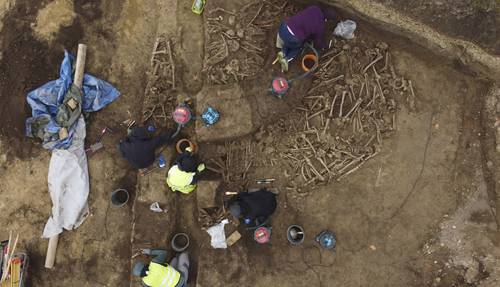Vienna While the construction teams removed land to renew a football field in Vienna last October, they ran into an unprecedented finding: a lot of skeletal remains intertwined in a common grave dating from the Roman Empire of the 1st century, probably the warriors bodies in a battle that involved Germanic tribes.
After an archaeological analysis, yesterday experts from the Vienna Museum made a first public presentation of the pit, linked to A catastrophic event in a military context
and evidence of the first known struggle in that region.
The bodies of 129 people have been confirmed on the site in the Simmering neighborhood in Vienna. The excavation teams also found many dyslocated bones and believe that the number of victims exceed 150, a discovery never seen before in Central Europe.
Michaela Binder, who led the archaeological excavation, said: Within the context of Roman war acts, there are no comparable combatant findings. There are huge battlefields in Germany where weapons were found. But finding the dead, that’s unique for all Roman history
.
The soldiers in the Roman Empire were typically cremated until the third century.
The pit where the bodies were deposited suggests a hurried or disorganized dump of corpses. Each skeleton examined showed signs of wounds, particularly in the head, torso and pelvis.
Battle wounds
Kristina Adler-Wölfl, head of the archaeological department of the city of Vienna, said: They have various battle wounds, which rules out the execution. It is truly a battlefield. There are sword wounds, spears; blunt trauma wounds
.
All the victims were men. The majority were between 20 and 30 years old and generally showed signs of good dental health.
Carbon-14 analysis helped date the bones between 80 and 130 AD. This was verified with the known history of the objects found in the pit: armor, helme cheeks, the nails used in the distinctive Roman military shoes known as Calaigae.
The most indicative track came from a rusty dagger of a type in use specifically between the middle of the 1st century and the beginning of the second.
The investigation continues: only a victim has been confirmed as a Roman warrior. Archaeologists expect DNA analysis and strontium isotopes to help identify the combatants more and to what side they were.
Adler-Wölfl commented: “The most likely theory at this time is that this is related to the campaigns of Emperor Domitian, that is from 86 to 96 AD”.
The city’s archaeologists said the discovery also reveals the first signs of the foundation of a settlement that would become today’s Austrian capital.
